- DGK Viper 8.125 Deck Review: An Overall Good Board - April 20, 2022
- Best Skateboard Bearings Guide: All You Need Consider - January 27, 2022
- Most Famous Old School Skateboarders - January 27, 2022
Setting up your ideal skateboard can be a very complex and tricky task. Especially if you are a beginner who has had to approach this all on your own. There are many components to worry about such as the board, the wheels, the trucks, the bearings, and the hardware. There are many things to worry about and each is just as important than the last. Without any of these, your skateboard simply won’t be the same. What we just mentioned are the essentials. However, there are several more optional accessories that can really enhance your skating experience.
One such component is skateboard risers. These are an additional consideration that can change your skateboard completely, allowing you to travel across certain terrain with more ease, keep you hardware tighter for longer and also look really cool if you buy from some stylish brands. However, you may be wondering why you need risers in the first place and what it is that they offer.
Well, in this guide we break down everything that there is to know about skateboard risers. So that you can decide if you need them, what risers are the best fit for you, and also, we will inform you of the different types and sizes of riser available. So without further delay. Here is our guide on how to find the best Skateboard Risers.
What are Skateboard Risers?
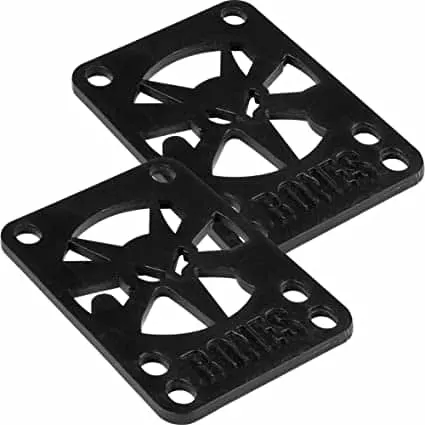
Skateboard risers are plastic skating accessories that are fitted between your skateboard and your trucks. These often come in different shapes and sizes, require specific hardware to fit your board properly, and depending on the size you choose, offer varied benefits. They come in various colors and styles and a wide variety of skateboard manufacturers will supply risers should you need or want them.
The purpose of these accessories is to raise your board higher off the ground when you are standing on it, essentially meaning that you will have taller trucks. If you have trucks with a high profile already, this may not be necessary but if you find that your board hangs low, you might benefit from riser pads.
What Do Skateboard Risers Do?
It really depends on who you ask. If you speak to a skater of past generations, they will quite openly (and in a rather closed-minded nature) tell you that they do nothing. This is likely due to the fact that riser pads are a relatively new accessory within the world of skateboarding. However, the purpose of risers is to primarily prevent skaters from experiencing wheel bite when they are skating. Wheel bite is when your wheel makes contact with the underside of the board when in motion, stopping the board and sending you flying forward.
This can often be avoided naturally with high-profile trucks or using any wheels smaller than 55 millimeters. However, if you don’t meet these requirements, you may want to invest in some risers.
What Are The Benefits Of Skateboard Risers?
So the main question that you are probably asking, is ‘what’s so good about skateboard risers anyway?’ Well, while the cynics out there might disagree, there are quite a few benefits to using risers when skating. So with that in mind, we aim to give you some insight into some of the most prominent reasons to invest in some risers. Check them out below:
- Avoiding Wheelbite: Firstly, as we mentioned above, when you use risers there is much less chance that you will experience wheel bite. If you ride and your hardware is loose, your wheels are larger than the average wheel or you ride with your trucks really loose as some skaters prefer to do. You run the risk of seeing your wheels catch with the underside of the board, leading to you taking a tumble forward, and because of the sheer shock factor, you probably won’t be equipped for the fall, making it all the more gnarly. So if this sounds like you, risers can help make this eventuality a thing of the past.
- Popping Bigger Ollies/tricks: While there are many skaters out there that completely disagree with this point, the fact remains that with your board higher off the ground, this allows for a bigger pop and as a result, a higher ollie. If you are used to riding without risers, this may take a bit of getting used to and can even lead to rocketed ollies for quite some time. However, if you are a complete beginner, you will reap all the benefits with none of the disadvantages. This can also make learning manuals a little bit easier as well so all in all, a pretty sound investment.
- Boards/wheels Last Longer: This is a point that piggybacks onto the first one. If you don’t experience as much wheel bite as you once did thanks to risers, that means one thing, your gear is going to look fresh much longer. If you bite your board regularly, not only will this make your board look less cool, it will eventually start to affect the structural integrity of the board. Plus, if your wheels keep rubbing this can lead to flat spots that render the wheel useless. So if you take away these scenarios, you have a board that looks and feels better for much, much longer.
- Aesthetically Pleasing: This will really depend on what risers you choose to go with as some of the best risers in terms of quality don’t necessarily look all that flashy. However, there are plenty of trusted brands that do offer risers that look the part and add a little more flair to your skateboard’s overall look. This can be a pop of colour, a logo, a cut-out stencil, a mismatched design, or just about anything you can imagine. Get creative and see what you can come up with.
- Shock Absorption: You will find that when you use risers, there is significantly less vibration when you ride the board. When you travel across rough terrain, you will feel the vibrations under your feet and this can be unpleasant for some, not to mention that the vibrations slowly loosen your hardware over time, a factor that often leads to wheel bite. However, with risers, this rarely happens as the shock absorption reduces the vibrations, keeps hardware tighter for longer and thus keeps you from suffering wheel bite. Also, when landing tricks, especially from large drops, you’ll often see that skateboards without risers will suffer from pressure cracks. This essentially starts a ticking clock and sadly, your board isn’t going to keep holding your weight for too much longer. However, with risers that absorb the shock of the fall, this becomes a much less common occurrence. So if you like to skate drops, banks, stair sets, and gaps, you’ll really want to invest in a pair of risers.
- Inexpensive: Then lastly, due to the fact that these components are essentially relatively thin strips of plastic, they aren’t all that pricey. You will tend to find risers in your local park for as little as $5. Meaning that you can improve your board’s durability, style, and performance without breaking the bank.
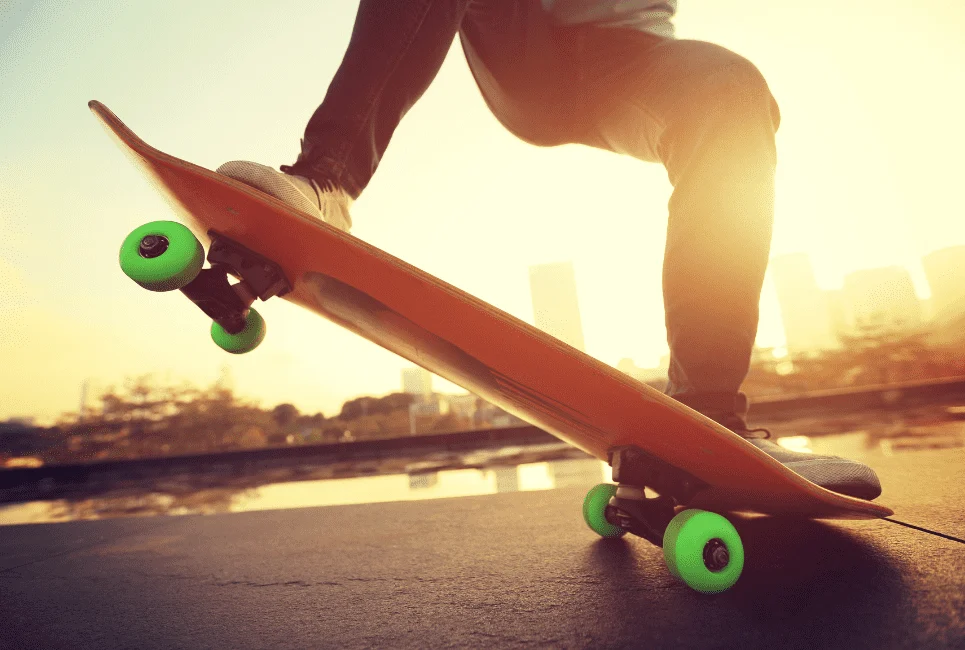
Risers Vs Shock Pads
While normal risers do have innate qualities that do offer a degree of shock absorption. There are specialized risers known as shock pads that are made from different materials which are better for the task at hand. polyurethane shock pads are more lightweight, flexible and offer much more shock absorption than their plastic counterparts. However, these tend to only come in 1/8 inch sizes. Meaning that if you actually want a decent-sized riser to compensate for large wheels for example, then you will have to go for the plastic option.
What Are the Disadvantages of Using Skateboard Risers?
While there are many benefits to adding risers to your setup, they aren’t without some accompanying disadvantages. You may be wondering what they are and we are all to happy to give you the lowdown. So here are the disadvantages of using risers:
Some Tricks Become Much Harder: With the added height, even if you are an experienced and skilled skater, some tricks will now feel unnatural. Tricks that require a scoop will be much harder to replicate due to the distance off the ground. Plus, tricks that require you to ollie may end up rocketed due to this added distance to pop the board. Some skaters will be able to adapt and overcome this difficult period, often achieving higher, sicker-looking tricks as a result. However, many other skaters will hate the process and in some cases, this can teach bad habits. So assess if this is worth the potential struggle before you commit.
Opens You Up to Ridicule: Now, let us stress that this is only from a small minority of skaters. However, that being said it is still worth mentioning. The old guard of skaters out there when they spot a set of risers, especially if they are big and chunky, tend to latch onto this and not let go. They tend to harp on about the uselessness of risers, how they look and feel horrible and that they only serve to make you a worse skater. Of course, they are entitled to their opinion, but that equally doesn’t mean you should be subjected to it. So if you choose to use risers, be aware of the company you keep. Only supportive skaters allowed.
What Hardware is Best For Each Type of Riser?
As we mentioned, there are quite a few different sizes of riser that you can purchase for your board. Depending on your truck profile and your wheels, you will need to accommodate them with a chunkier wedge. However, to do this, you will need to buy hardware with longer bolts to match the added height that the risers provide. This is something that you can’t simply take for granted or eyeball. So here is a size chart, allowing you to match your hardware to your riser and avoid any frustration when building your board:
- No risers: 7/8 to 1″ Hardware
- 1/8 riser or shock pad: 1″ or 1 & 1/8 hardware
- 1/4 riser: 1 1/4″ hardware
- 1/2 riser: 1 1/2″ hardware
What Are Angled Risers?
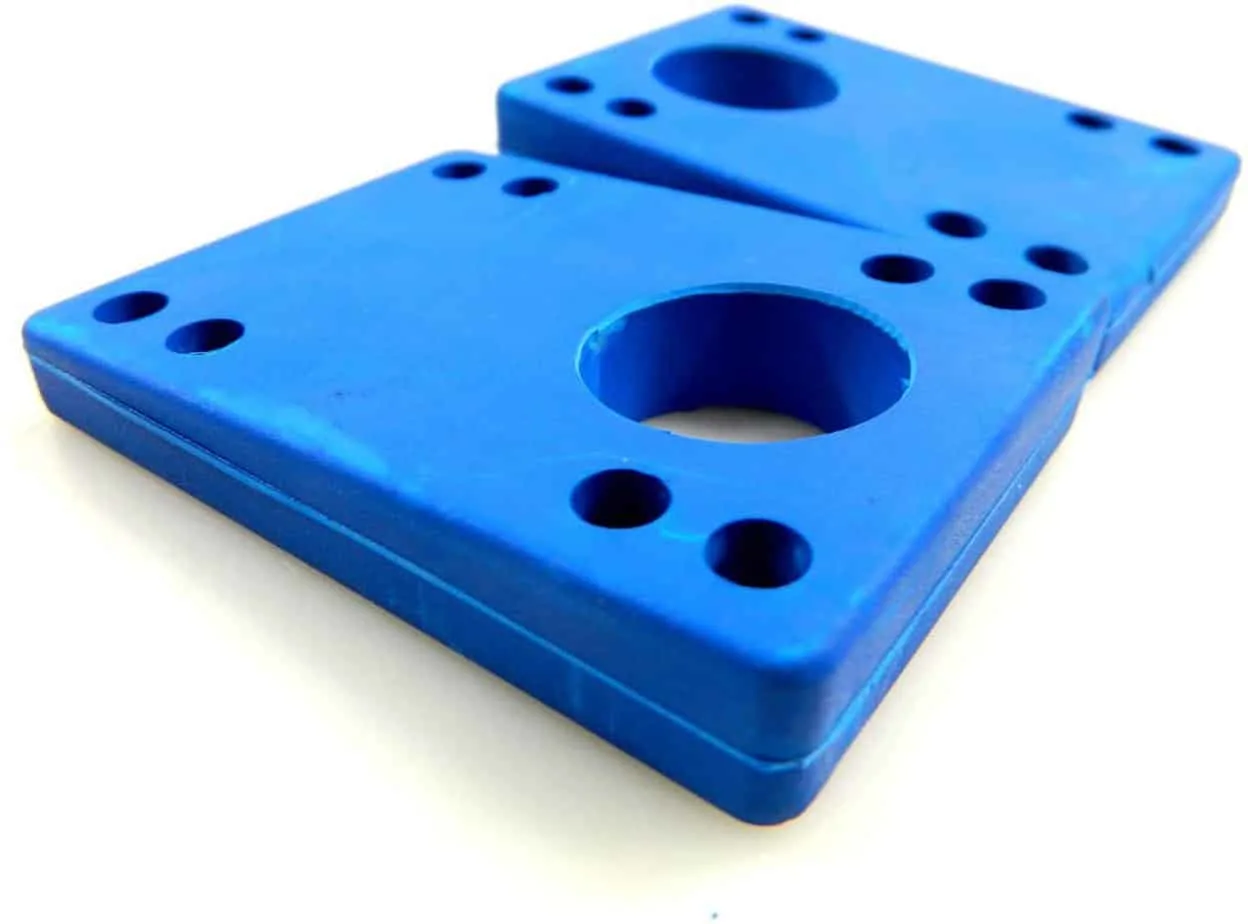
Angled risers are something that you won’t really find in conventional skateboarding. They aren’t used in very, street or freestyle skating. Primarily, they are used as a better means of transportation when using a cruiser or a longboard. These risers allow the skater to enjoy a much more fluid and sharper range of motion when turning. Almost allowing the skater to pivot without any need to ever tip the nose up. It’s ideal for bombing hills, weaving through crowds, and generally getting around on your board. However, these risers are not great when it comes to skating in a more competitive sense. So, by all means, use them when traveling to the park but not when you arrive.
Who Make The Best Skateboard Risers?
Now, you may have read through the above sections and sold yourself on the idea of getting some risers. However, it can be a little overwhelming when it comes to choosing risers that are fit for purpose. There are so many options and an abundance of brands. So with that in mind, we aim to offer you options that tick all the boxes. Check out our suggestions below:
Best Looking Risers – Diamond Supply Risers
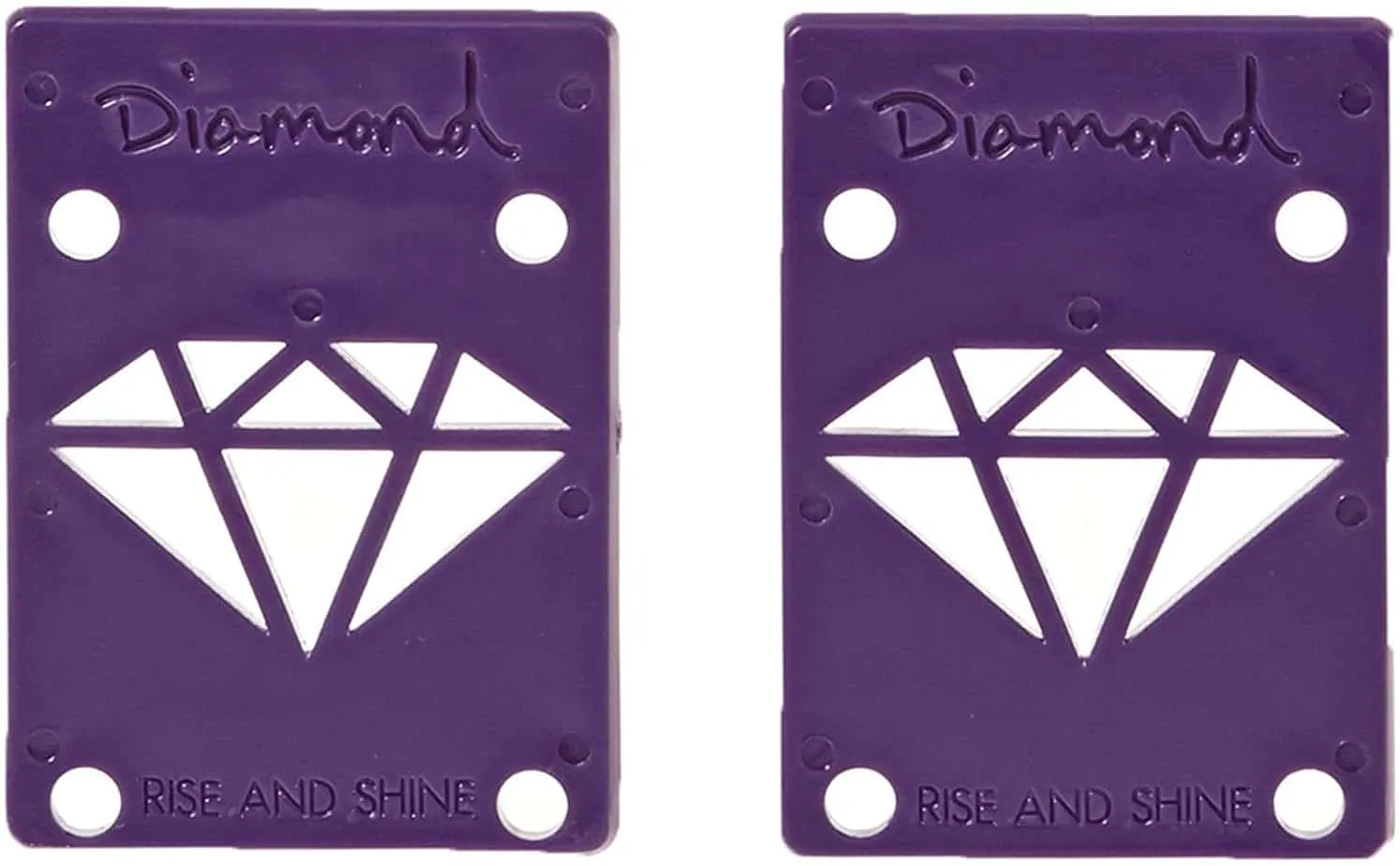
Was is more luxurious and eye-catching than a diamond. Not much in our opinion which is probably why we have chosen diamond Supply’s range of risers. These come in a variety of different colors and offer a stencil that bares the companies logo in a cut-out design. We would suggest the red design as this is most similar to the branding on their apparel and other products. Plus, the risers are of great quality too. So for style and performance, these are a great choice.
Best Performance Risers – Independent Genuine Parts Risers
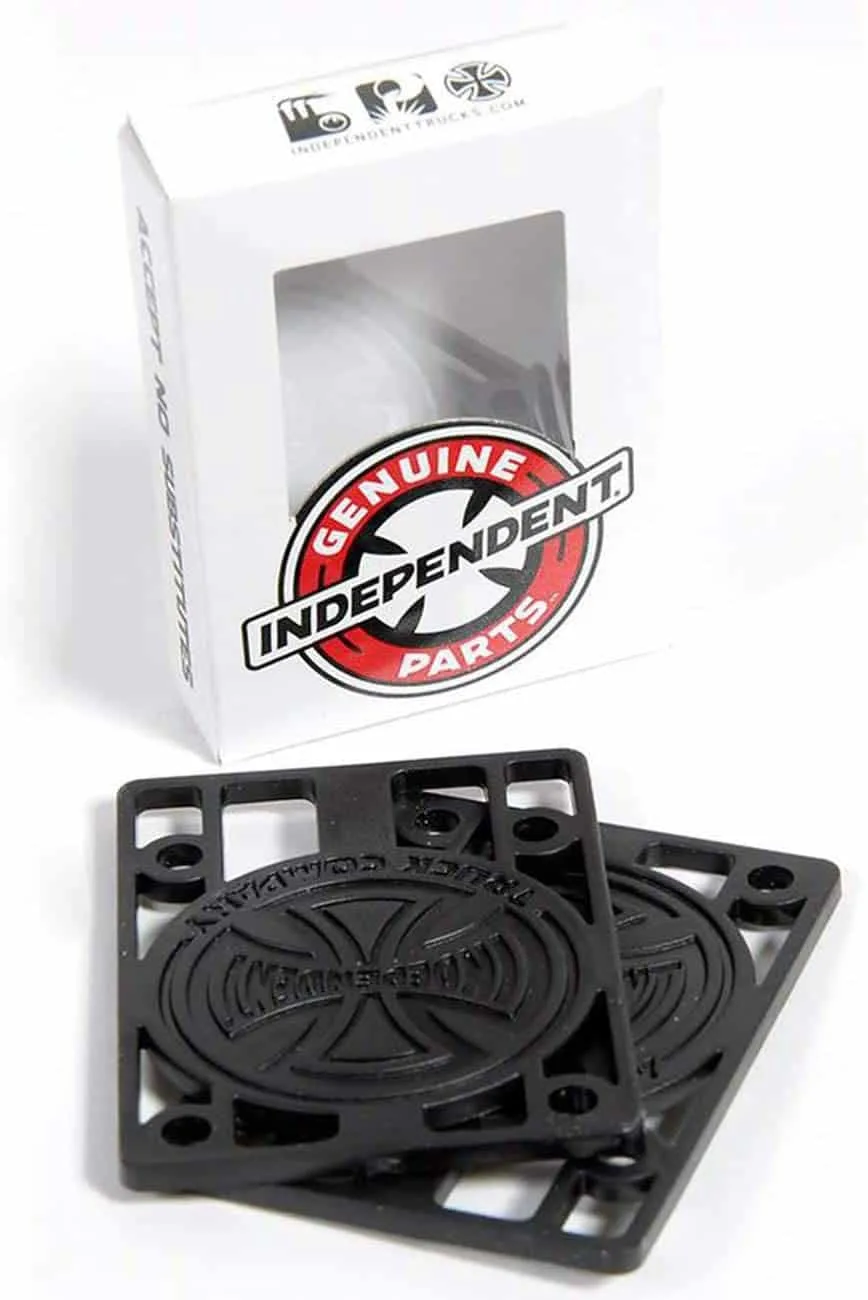
When it comes to skating accessories, you have to do a hell of a lot right to overshadow Indy and in this case, no one does. Independent offers the finest range of risers on the market, all with the company logo stencils or cut out in a stylish manner and each riser is just about the best quality component of this nature that money can buy. So if you want the best, skip the rest and trust in Indy.
Best Shock Pads – Independent 1/8 Shock Pads
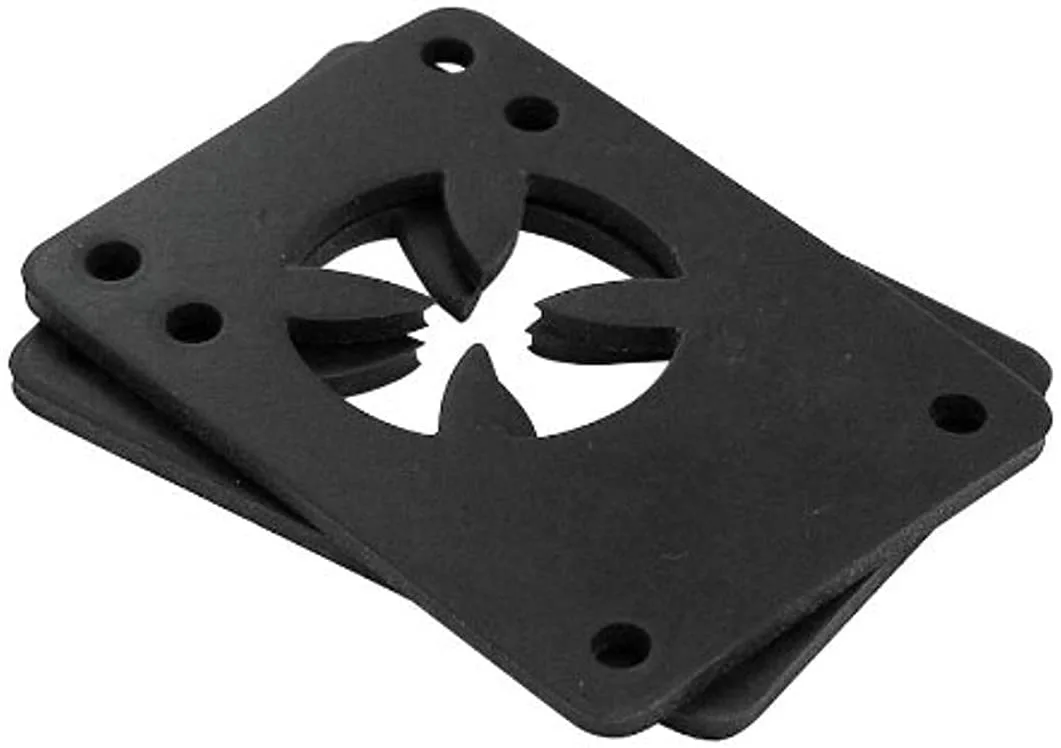
Once again, Independent leads the way, and this time it’s with regards to the more specific, more lightweight, and flexible shock pads. These pads are very flexible, very lightweight, you will barely notice that they are there when doing tricks. Yet when traveling over harsh terrain, you’ll immediately notice the change for the better.
Value For Money Option – MiniLogo Rigid Riser Pads
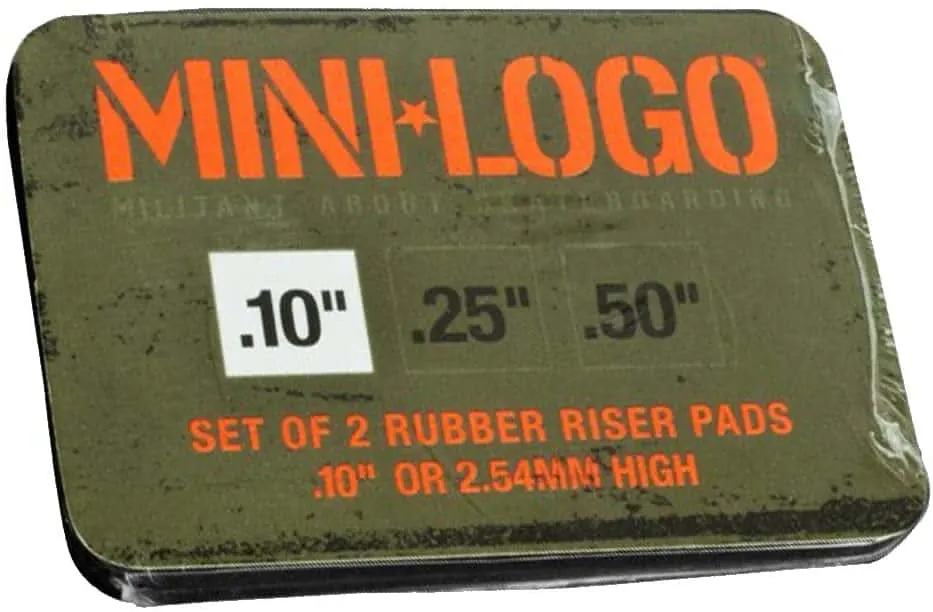
It’s hard to truly offer up a value for money option when it comes to risers, simply because risers are so inexpensive, to begin with. However, if you want good quality at low prices, the best option tends to be, at least in our opinion, Mini Logo. These come in about $2 cheaper than the majority of other risers on the market but still offer the same variety of colors, durability, and quality as leading brands. They are rigid and therefore don’t offer a lot of shock absorption but you can’t have it all unless you pay premium prices. All in all, this is a great option.
How to Put on Your Risers
We hope that now you have come to a decision and got your hands on some skateboard risers to help you avoid wheel bite and ride with more freedom and ease. However, you may be sitting there with board and trucks separate wondering how to attach them to your board. Well, here is a quick step by step guide just in case you need a hand:
- Step one: Remove your trucks if you haven’t already and turn your board so that the graphic side is face up.
- Step two: Place your risers in the spaces that your trucks usually occupy, lining up the holes with those which accommodate the truck bolts.
- Step three: Place your trucks over the top of the risers, again lining up the bolt holes and then slip the bolts into the holes so that the tread is facing toward the sky.
- Step four: Attach the nuts to the bolts until they are finger tight and then use an Allen key and skate tool to tighten each bolt as much as possible.
What Pros Use Skateboard Risers?
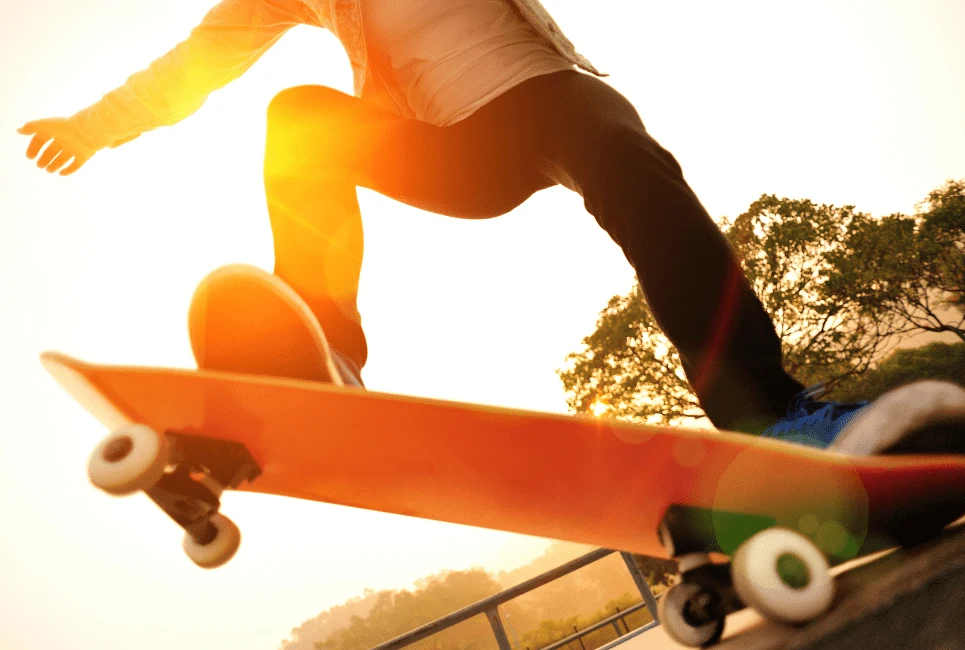
Risers aren’t really used in pro skateboarding as the wheels tend to be no larger than 55mm. Plus, skaters will tend to wax their boards where the bite occurs rather than accommodate it. However, despite this, there are a few prominent skaters that have been known to use risers when they skate. Here are a few pro skaters that you may know who are partial to using a riser:
- Aaron Kyro
- Andrew Allen
- Nick Boserio
- Erick Winkowski
- Kader Sylla
Rise and Grind!
As you can see from the information above, while risers down get a lot of love in the skating community, many skaters will find that using them comes with various benefits. Better pops, board durability, less wheel biting and sharper turning are only some of the benefits that you will notice. So if this sounds like something you want when to set up your new rig then be sure to add some risers to your build.
FAQ Section
If you have reached the end of this guide and you still don’t have what you need, don’t panic. We have an FAQ section that aims to put all of those lingering queries to bed. Check it out below:
Answer: Why, it’s because he’s a pro skateboarder from the San Francisco Bay Area. Jokes aside though, Aaron may be more of an influencer than a pro skateboarder but Kyro has managed to build quite a career in skating. He has built the Braile Skateboarding brand from the ground up, is part of the very successful Revive Skateboarding company, has taught thousands of skaters everything from an ollie to a tre-flip. Plus, most importantly, he has managed to compete somewhat with some of the biggest names out there. You can even catch him in the upcoming BATB XII bracket. So keep an eye out for that or head over to the Braille Skateboarding Youtube channel for some fun skating content.
Answer: You may be wondering after going through the process of choosing a set of risers just how much you will pay for an entire setup. Now, this will vary depending on if you buy a complete or a DIY board. However, we are going to assume that you go for a DIY board because ultimately, this ensures more quality builds in the long run. So with that in mind, here is the average price you should aim to pay for each component:
♦ Board: £80
♦ Trucks: £50
♦ Wheels: £40
♦ Bearings: £20
♦ Hardware: £5
♦ Risers: £3
Answer: You may also have seen the term longboard being thrown about in this article and be wondering, just how many types of skateboard there are out there. Well, allow us to inform you. Here is every type of skateboard that you can find in your local shop:
♦ Popsicle boards (shortboards)
♦ Cruisers
♦ Longboards
♦ Penny boards
♦ Old Skool boards
♦ Mini boards
♦ Penny Nickels
♦ Caster Boards
♦ Downhill longboard
So that is our guide giving you all the info you could ever need surrounding the topic of skate board risers. What do you make of this guide? Was this helpful and informative for you? What do you personally think of using risers? Let us know in the comments section below and as always, thank you for reading.
Looking for more interesting readings? Check out:

